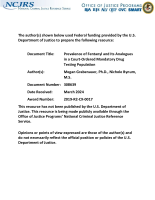Hair analysis
Improving Telogen Hair Analysis by Predicting Nuclear and Mitochondrial DNA Success for Massively Parallel Sequencing Using Microscopic and qPCR Methods
An Exploration of the Effects of Taphonomy on Isotope Ratios of Human Hair
Development of a matrix-matched standard for the elemental analysis of human hair by LA-ICP-MS
Hair Root Staining – What Can Hematoxylin Do for Your Laboratory?
Hair evidence collected as part of a forensic investigation has the potential to provide valuable source information through DNA analysis of its root. This webinar discusses the process of utilizing Hematoxylin staining in forensic casework as an indicator of hair root DNA suitability. The presenters demonstrate the process of staining hair roots with Hematoxylin, as well as provide visual examples of stained hair roots.
See the YouTube Terms of Service and Google Privacy Policy
Proteomic Analysis of Single Hairs
Hair Assays for Drugs of Abuse in a Probation Population: Implementation of a Pilot Study in a Correctional Field Setting; Final Report
Patterns of Concordance Between Hair Assays and Urinalysis for Cocaine: Longitudinal Analysis of Probationers in Pinellas County, Florida (From The Validity of Self-Reported Drug Use: Improving the Accuracy of Survey Estimates, P 161-199, 1997, Lana Harrison and Arthur Hughes, eds. - See NCJ 167339)
SNP Miniplexes for Individual Identification of Random-Bred Domestic Cats
HAIR ANALYSIS FOR DRUGS OF ABUSE: FINAL REPORT
Dyed Hair and Swimming Pools: The Influence of Chlorinated and Nonchlorinated Agitated Water on Surface-Enhanced Raman Spectroscopic Analysis of Artificial Dyes on Hair
Microscopical Discrimination of Human Head Hairs Sharing a Mitochondrial Haplogroup
Forensic Discrimination of Dyed Hair Color: II. Multivariate Statistical Analysis
Forensic Discrimination of Dyed Hair Color: I. UV-Visible Microspectrophotometry
Advancing Justice for the Missing and Unidentified Through Research - 2024 NIJ Research Conference
Forensic science research is developing essential knowledge to fill in the holes in death investigations, creating new ways to identify challenging skeletal remains. These methods inform cause of death, time of death, and familial relationships to guide investigations, identify suspects, support prosecutions, and bring justice to families.
See the YouTube Terms of Service and Google Privacy Policy



